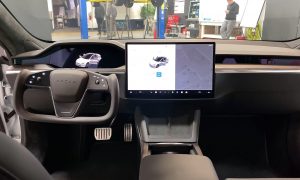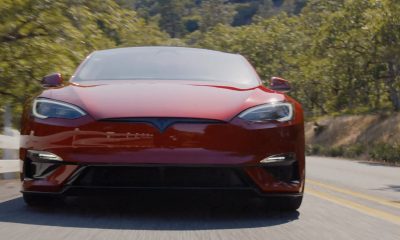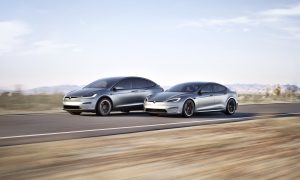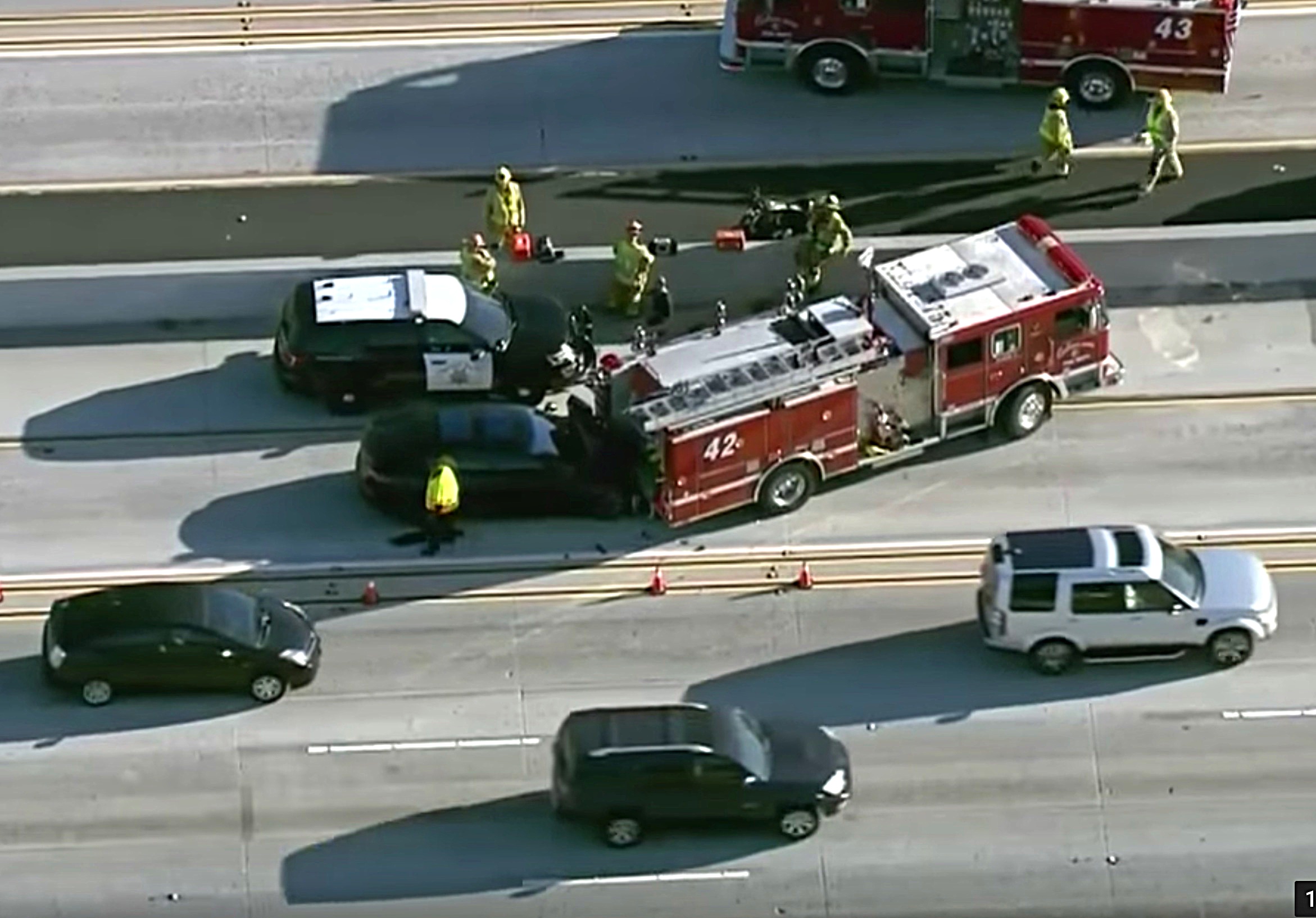

News
Tesla Model S firetruck crash in California: What we know so far
All eyes are on Tesla once more, after a Model S traveling at highway speeds crashed into a parked fire truck in Culver City, California earlier this week. The collision, which allegedly happened while the car was on Autopilot, has incited renewed debates, criticisms, and an upcoming government probe on Tesla and its evolving driving-assist software.
As more details about the accident emerge, here is a brief discussion on the latest and most pertinent information relating to the recent Model S collision.
The accident
As we stated in a previous report, the Tesla Model S was traveling at 65 mph on Interstate 405 on Monday morning when it crashed into a stationary fire truck. The emergency vehicle was parked on the road after being deployed to a separate accident in the area.
The driver of the electric car was able to walk away unharmed from the accident. Upon being questioned by the authorities, the Model S driver stated that the vehicle was on Autopilot when it collided with the parked fire truck. Tesla released a brief statement on Monday, stating that Autopilot is intended only to be used by an attentive driver.
More details emerge
As the online forum community continued to debate about the benefits and risks of Tesla’s Autopilot software, a member of the r/TeslaMotors subreddit who claimed to know the driver of the crashed Model S spoke up and provided some details about the accident. According to the Redditor, the Model S was traveling behind a pickup truck with Autopilot engaged. Due to the truck’s size, the Tesla’s driver was unable to see beyond the vehicle in front.
“The driver of the Tesla is my dad’s friend. He said that he was behind a pickup truck with AP engaged. The pickup truck suddenly swerved into the right lane because of the firetruck parked ahead. Because the pickup truck was too high to see over, he didn’t have enough time to react.” notes mikhpat.
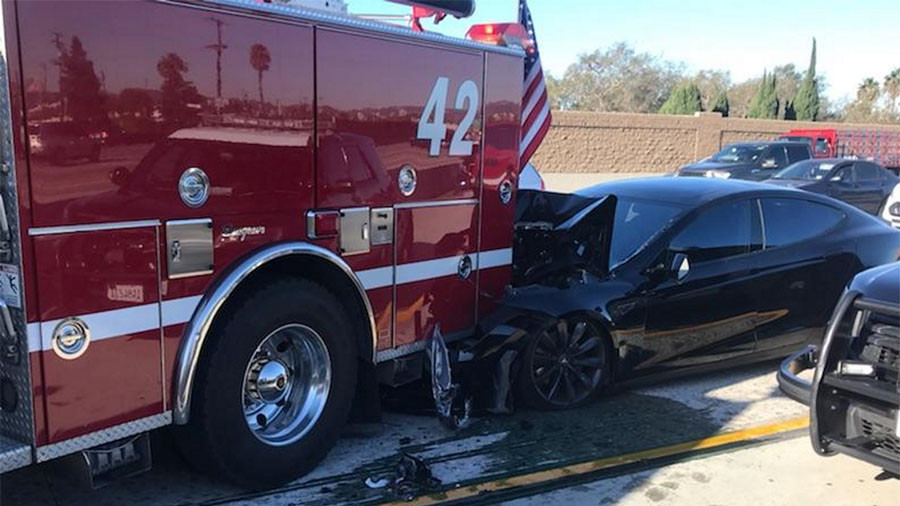
Tesla Model S crashes into a stationary firetruck [Credit: Culver City Fire Department via Twitter]
Tesla’s Autopilot system allegedly did not have enough time to react while driving at 65 mph. The driver stated that the Model S’ emergency braking system might have activated moments before the car hit the emergency vehicle, but he could not be certain, according to mikhpat‘s statement.
“As for the 65mph detail, the braking system could’ve intervened before the collision, but there’s no way he could tell.”
The impact was strong enough to push the steering wheel two feet into the cabin, however. The Model S driver had some minor cuts and bruises from the accident but was otherwise unharmed. According to the Redditor, the driver admits that he was at fault for not paying close attention to the road. The Model S owner also refused to blame Tesla for the accident.
While it’s still unconfirmed if Tesla’s Autopilot suite, including Traffic-Aware Cruise Control and Autosteer, was activated at the time of the accident, Tesla’s Model S Owner’s Manual warns of a similar scenario that would not be detected by the driving-assist system.
According to the About Drive Assistance section of the owner’s manual:
“Traffic-Aware Cruise Control cannot detect all objects and may not brake/decelerate for stationary vehicles, especially in situations when you are driving over 50 mph (80 km/h) and a vehicle you are following moves out of your driving path and a stationary vehicle or object is in front of you instead.”
The warning appears to mimic the exact situation being described by Redditor mikhpat.
The investigations begin
As the online forum community exploded amidst heated debates on who is to blame for the recent Model S collision, the US National Transportation Safety Board announced that it is sending two of its investigators to California to study the crash. According to the NTSB, the investigators will be examining both “driver and vehicle” factors in Monday’s accident.
By Tuesday, the National Highway Traffic Safety Administration announced that it is also sending a team of investigators to California to evaluate the recent accident, as well as to assess any “lessons learned” from the crash, as noted in a Bloomberg report. The NHTSA did not specify which team of investigators it was sending to California, but expectations are high that the regulating body would be deploying its Special Crash Investigations unit.
Elon Musk
Tesla reveals it is using AI to make factories more sustainable: here’s how
Tesla is using AI in its Gigafactory Nevada factory to improve HVAC efficiency.

Tesla has revealed in its Extended Impact Report for 2024 that it is using Artificial Intelligence (AI) to enable its factories to be more sustainable. One example it used was its achievement of managing “the majority of the HVAC infrastructure at Gigafactory Nevada is now AI-controlled” last year.
In a commitment to becoming more efficient and making its production as eco-friendly as possible, Tesla has been working for years to find solutions to reduce energy consumption in its factories.
For example, in 2023, Tesla implemented optimization controls in the plastics and paint shops located at Gigafactory Texas, which increased the efficiency of natural gas consumption. Tesla plans to phase out natural gas use across its factories eventually, but for now, it prioritizes work to reduce emissions from that energy source specifically.
It also uses Hygrometric Control Logic for Air Handling Units at Giafactory Berlin, resulting in 17,000 MWh in energy savings each year. At Gigafactory Nevada, Tesla saves 9.5 GWh of energy through the use of N-Methylpyrrolidone refineries when extracting critical raw material.
Perhaps the most interesting way Tesla is conserving energy is through the use of AI at Gigafactory Nevada, as it describes its use of AI to reduce energy demand:
“In 2023, AI Control for HVAC was expanded from Nevada and Texas to now include our Berlin-Brandenburg and Fremont factories. AI Control policy enables HVAC systems within each factory to work together to process sensor data, model factory dynamics, and apply control actions that safely minimize the energy required to support production. In 2024, this system achieved two milestones: the majority of HVAC infrastructure at Gigafactory Nevada is now AI-controlled, reducing fan and thermal energy demand; and the AI algorithm was extended to manage entire chiller plants, creating a closed-loop control system that optimizes both chilled water consumption and the energy required for its generation, all while maintaining factory conditions.”
Tesla utilizes AI Control “primarily on systems that heat or cool critical factory production spaces and equipment.” AI Control communicates with the preexisting standard control logic of each system, and any issues can be resolved by quickly reverting back to standard control. There were none in 2024.
Tesla says that it is utilizing AI to drive impact at its factories, and it has proven to be a valuable tool in reducing energy consumption at one of its facilities.
Elon Musk
Tesla analysts believe Musk and Trump feud will pass
Tesla CEO Elon Musk and U.S. President Donald Trump’s feud shall pass, several bulls say.

Tesla analysts are breaking down the current feud between CEO Elon Musk and U.S. President Donald Trump, as the two continue to disagree on the “Big Beautiful Bill” and its impact on the country’s national debt.
Musk, who headed the Department of Government Efficiency (DOGE) under the Trump Administration, left his post in May. Soon thereafter, he and President Trump entered a very public and verbal disagreement, where things turned sour. They reconciled to an extent, and things seemed to be in the past.
However, the second disagreement between the two started on Monday, as Musk continued to push back on the “Big Beautiful Bill” that the Trump administration is attempting to sign into law. It would, by Musk’s estimation, increase spending and reverse the work DOGE did to trim the deficit.
Every member of Congress who campaigned on reducing government spending and then immediately voted for the biggest debt increase in history should hang their head in shame!
And they will lose their primary next year if it is the last thing I do on this Earth.
— Elon Musk (@elonmusk) June 30, 2025
President Trump has hinted that DOGE could be “the monster” that “eats Elon,” threatening to end the subsidies that SpaceX and Tesla receive. Musk has not been opposed to ending government subsidies for companies, including his own, as long as they are all abolished.
How Tesla could benefit from the ‘Big Beautiful Bill’ that axes EV subsidies
Despite this contentious back-and-forth between the two, analysts are sharing their opinions now, and a few of the more bullish Tesla observers are convinced that this feud will pass, Trump and Musk will resolve their differences as they have before, and things will return to normal.
ARK Invest’s Cathie Wood said this morning that the feud between Musk and Trump is another example of “this too shall pass:”
BREAKING: CATHIE WOOD SAYS — ELON AND TRUMP FEUD “WILL PASS” 👀 $TSLA
She remains bullish ! pic.twitter.com/w5rW2gfCkx
— TheSonOfWalkley (@TheSonOfWalkley) July 1, 2025
Additionally, Wedbush’s Dan Ives, in a note to investors this morning, said that the situation “will settle:”
“We believe this situation will settle and at the end of the day Musk needs Trump and Trump needs Musk given the AI Arms Race going on between the US and China. The jabs between Musk and Trump will continue as the Budget rolls through Congress but Tesla investors want Musk to focus on driving Tesla and stop this political angle…which has turned into a life of its own in a roller coaster ride since the November elections.”
Tesla shares are down about 5 percent at 3:10 p.m. on the East Coast.
Elon Musk
Tesla scrambles after Musk sidekick exit, CEO takes over sales
Tesla CEO Elon Musk is reportedly overseeing sales in North America and Europe, Bloomberg reports.

Tesla scrambled its executives around following the exit of CEO Elon Musk’s sidekick last week, Omead Afshar. Afshar was relieved of his duties as Head of Sales for both North America and Europe.
Bloomberg is reporting that Musk is now overseeing both regions for sales, according to sources familiar with the matter. Afshar left the company last week, likely due to slow sales in both markets, ending a seven-year term with the electric automaker.
Tesla’s Omead Afshar, known as Elon Musk’s right-hand man, leaves company: reports
Afshar was promoted to the role late last year as Musk was becoming more involved in the road to the White House with President Donald Trump.
Afshar, whose LinkedIn account stated he was working within the “Office of the CEO,” was known as Musk’s right-hand man for years.
Additionally, Tom Zhu, currently the Senior Vice President of Automotive at Tesla, will oversee sales in Asia, according to the report.
It is a scramble by Tesla to get the company’s proven executives over the pain points the automaker has found halfway through the year. Sales are looking to be close to the 1.8 million vehicles the company delivered in both of the past two years.
Tesla is pivoting to pay more attention to the struggling automotive sales that it has felt over the past six months. Although it is still performing well and is the best-selling EV maker by a long way, it is struggling to find growth despite redesigning its vehicles and launching new tech and improvements within them.
The company is also looking to focus more on its deployment of autonomous tech, especially as it recently launched its Robotaxi platform in Austin just over a week ago.
However, while this is the long-term catalyst for Tesla, sales still need some work, and it appears the company’s strategy is to put its biggest guns on its biggest problems.
-

 Elon Musk2 days ago
Elon Musk2 days agoTesla investors will be shocked by Jim Cramer’s latest assessment
-

 News7 days ago
News7 days agoTesla Robotaxi’s biggest challenge seems to be this one thing
-

 News2 weeks ago
News2 weeks agoTesla’s Grok integration will be more realistic with this cool feature
-

 Elon Musk2 weeks ago
Elon Musk2 weeks agoElon Musk slams Bloomberg’s shocking xAI cash burn claims
-

 News2 weeks ago
News2 weeks agoTesla China roars back with highest vehicle registrations this Q2 so far
-

 News2 weeks ago
News2 weeks agoTexas lawmakers urge Tesla to delay Austin robotaxi launch to September
-

 News2 weeks ago
News2 weeks agoTesla dominates Cars.com’s Made in America Index with clean sweep
-

 Elon Musk1 week ago
Elon Musk1 week agoFirst Look at Tesla’s Robotaxi App: features, design, and more


